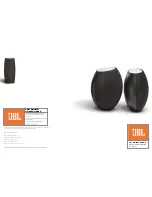
2.3 CONNECTING YOUR SPEAKERS
The types of cable used to connect the speakers to the power amplifier will marginally affect the sound. The
cross-sectional area of the cable should be large enough so as not to affect the damping factor; generally a cable
with a cross-sectional area of 2.5 mm
2
, or greater is recommended. The ellipse 8 passive and 10 passive terminal
panels offer the option of Bi-Wiring. Bi-Wiring provides the facility for connecting separate feeds from the amplifier to the
low Frequency and High Frequency sections of the crossover network. This method of connection can provide better
instrument separation, localisation, and imaging depth compared with conventional wiring for the cost of another set of
speaker cables. Bi-wiring provides for separate feed and return cables for low frequencies and high frequencies, low
and high frequencies being differentiated by the crossover point of the loudspeaker system; please refer to the technical
specifications. This reduces intermodulation effects at high and low frequencies within the cables.
The lower the resistance of the cable between the amplifier and the speakers, the better the damping factor acting on the
speaker. This has been covered in every audio magazine that has ever been written about speakers, so we won’t beat it
to death here. You don’t need to buy speaker cable that costs as much as your speakers. To get the most benefit, select
a finely stranded high purity copper speaker cable and dress the cable ends to prevent “hairs” or stray conductors from
shorting across the terminals. If your amplifier terminals will not directly accept your chosen size of cable, you can trim
down the cable size at the amplifier end. Ensure that the binding post retaining nuts on both the loudspeakers and the
amplifier are screwed down firmly without stripping or over tightening them. Ellipse Passive monitors loudspeakers are
shipped ready for standard cable wiring with shorting bars connecting both halves of the crossover together. Keep the
shorting bars in place whilst connecting your cable if not using the Bi-wire facility.
To Bi-wire your loudspeakers remove the shorting bars completely from the terminals of the crossover panel. prepare
2 sets of cables for each loudspeaker, labeling one for HF (High Frequencies) and the other for lF (low Frequencies)
paying particular attention to the polarity of the conductors within the cable. Keep positive and negative conductors
(red and Black) connected to the respective red and black terminals. parallel both positive conductors and both negative
conductors together for the left hand cables at the left hand amplifier terminals. Repeat for the right hand loudspeaker
and conductors at the right hand amplifier terminals.
2.4 OBSERVING POLARITY
You already know about connecting the positive terminal on the amplifier to the positive terminal on the speakers, and
ensuring that both channels are “in phase” by checking to ensure that there’s more bass with both speakers on and
not less bass. Absolute polarity is a bit trickier to confirm but is nevertheless very important. Absolute polarity is the
maintenance of a positive pressure wave from the microphone capsule all the way through to the listener. a kick drum, for
instance, has the drum skin whacked by the foot pedal, and it pushes the air, which pushes the microphone diaphragm,
which generates a signal through the electronics and should eventually come out of the speakers as a positive acoustic
pressure wave. This means the speaker cones will move towards you, just like the drum skin. all Tannoy monitors have
absolute positive polarity which means that a positive going electrical input pulse to the red terminals will move the cones
towards you. However, you can’t trust a conventional recorded source to test this because there is no way to confirm that
absolute polarity was maintained throughout the recording chain; it can even change from track to track. This isn’t a trivial
thing, especially when you’re using a true stereo microphone setup, or trying to accurately place things in your mix. This
is something that should be rigorously checked with every microphone and every signal line in a studio; but the first step
would be to use the kick drum test described above with a few microphones. if you don’t believe it can make a difference,
set up a little test using a mix you know and flip the polarity of both monitor channels at the same time. The imaging will
flip from vague (negative polarity) to strong (positive polarity).Hear-Believe!
2.5 POWER AMPLIFIERS
The power amplifier should be reasonably well matched in power to the power rating of the speakers (see specifications).
The use of a more powerful amplifier (i.e. in excess of the recommended figure) provides increased headroom, which
is useful especially for highly dynamic programme material. Due to the high peak power handling of Tannoy monitors,
responsible use of more powerful amplifiers should not represent a danger to the speakers as long as the amplifiers are
not overdriven.
Summary of Contents for Ellipse 10 Passive
Page 1: ...p a s s i v e owner s manual ...
Page 11: ...NOTES ...






























